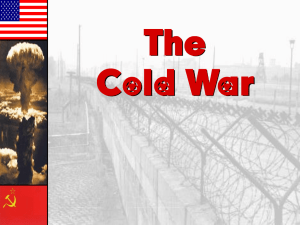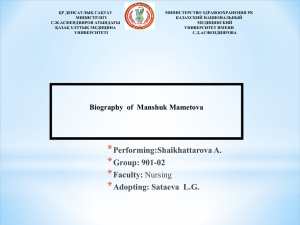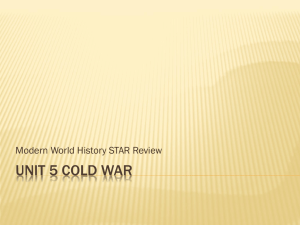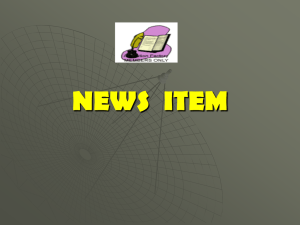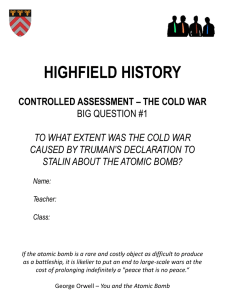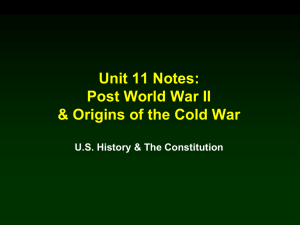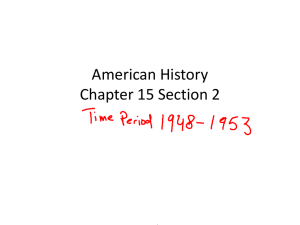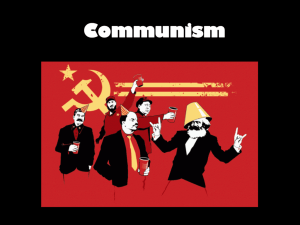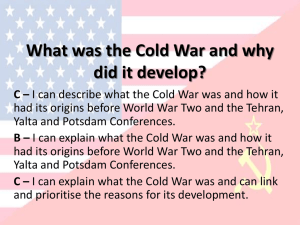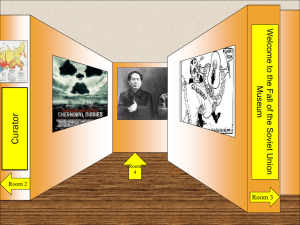The Cold War
advertisement
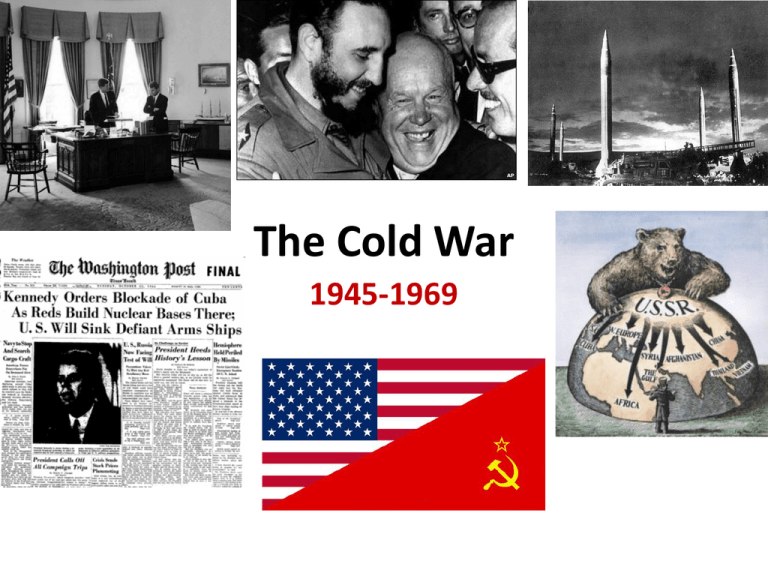
The Cold War 1945-1969 Learning Objectives THE COLD WAR AND THE FIFTIES • • • • • • • • 106. Describe the U.S. responses to Soviet aggression after World War II, including the Truman Doctrine, the Marshall Plan, the North Atlantic Treaty Organization, [and the Berlin Airlift] (containment, the Cuban Missile Crisis). (TEKS US 6D) (TAKS 1) 107. Describe the impact of the Cold War on the business cycle and defense spending (military-industrial complex and weapons of mass destruction). (TEKS US 14C) 108. Describe the impacts of the G.I. Bill, the election of 1948 (Truman, Dewey, Thurmond, and the Dixiecrats), McCarthyism, and Sputnik I (the space race). (TEKS US 6F) (TAKS 1) 109. Identify the causes and effects of prosperity in the 1950s (increased military spending and the growth of the suburbs). (TEKS US 14B) 110. Analyze the conflict in Korea and describe the domestic and international effects (United Nations and Douglas MacArthur). (TEKS US 6E) (TAKS 1) 111. Analyze how scientific discoveries and technological innovations, including those in transportation and communication, have changed the standard of living in the United States (television, the interstate highway system, and the H-bomb). (TEKS US 23A) (TAKS 3) 112. Explain the effects of scientific discoveries and technological innovations such as medical vaccinations and computers on the development of the U.S (polio vaccine). (TEKS US 22A) (TAKS 3) 113. Identify examples of American art, music, and literature that transcend American culture and convey universal themes (beatniks, rock and roll music, and abstract expressionism). (TEKS US 20C) Key Terms • Cold War: an era of confrontation and competition between the US and the Soviet Union that lasted from 1946-1990. • Containment: a US Cold War policy of keeping communism within its present territory through the use of diplomatic, economic and military actions. • Truman Doctrine: a doctrine proclaimed by President Harry Truman in March, 1947; it sought to (1) stabilize Greece and Turkey from a Communist takeover; (2) it pledged the United States to fight communism worldwide • Marshall Plan: Proposed by Secretary of State George C. Marshall in June, 1947; it provided European nations American aid to rebuild their economies after World War Two. It provided billions of dollars worth of supplies, machinery, and food into Western Europe. Key Terms • GI Bill (1944): also known as the Servicemen’s Readjustment Act, this act boosted the economy by providing generous loans to veterans to help them establish businesses, buy homes, and attend college. • Berlin Airlift: June 1948, the US used cargo planes to supply Berliners with food and medicine that had been cut off from the Soviet Union • NATO: North Atlantic Treaty Organization; a mutual defense alliance established in April, 1949, including the US, Canada, Britain, France, Italy and other countries • Mao Zedong: leader of the Communists forces in China that overthrew the Nationalists government (led by Chiang Kai-Shek) in1949. Origins of the Cold War • Following the end of World War Two, tensions between the US and the USSR increased because each country had different goals. – The Soviets wanted to keep Germany weak to prevent future threats from Eastern Europe – Soviets believed in the superiority of Communism and viewed capitalist nations with suspicion. • The USA believed: – the Great Depression had caused World War II – Americans viewed economic growth as key to world peace. – Americans sought to promote democracy and free enterprise Yalta Conference • Held in February 1945, near the end of World War II. • Held at a Soviet resort near the Black Sea • Roosevelt (US), Churchill (England), and Stalin (USSR) • Roosevelt and Churchill agree to recognize the Soviet government in Poland • Issue the Declaration of Liberated Europe: asserted the right of all people to choose the form of government under which they will live (Feb, 1945) Yalta Conference • Dividing Germany • The Big 3 agree to divide Germany into four zones: – – – – • Great Britain Soviet Union France US City of Berlin also divided Potsdam Conference: July, 1945 • President Truman takes control following death of FDR on April 11, 1945. • In July, 1945, Truman met Stalin at Potsdam, near Berlin • Discussed: – Future of Germany – issue of war reparations The Iron Curtain • After WW2, the USSR refused to make any concessions or uphold the Declaration of a Liberated Europe. • The Soviet Army in Eastern Europe established pro-Soviet Communists governments • These countries came to be called satellite nations. Containment • George Kennan • The Long Telegram • Only a matter of time until major economic and political weaknesses undid the Soviet Union • “Containment” • Crisis in Iran (1946) The Truman Doctrine (March, 1947) • Action taken in defense of Soviet ambitions to control Turkey and Communist guerilla war in Greece. – Fears that Soviets wanted to dominate the Middle East • Truman speech that called for aid to “free peoples who are resisting attempted subjugation by armed minorities or by outside pressures.” – Stabilize Greece • Pledged the US to fight Communism worldwide The Marshall Plan • June, 1947: US gave European nations American aid to rebuild their economies. The Berlin Crisis and Airlift • Disagreement over post-war Germany eventually brought the US and USSR to the brink of war. • Early 1948: US, German, and France create the federal Republic of Germany • Allowed the West Germans to have their own government • June, 1948, USSR cuts all road and rail traffic to West Germany • Truman orders the Berlin airlift (11 months) Berlin Wall • Later, in July, 1961, the Soviet Union demanded the US, Great Britain, and France withdraw from West Berlin. • President Kennedy refused. • The Soviet Union responded by building the Berlin Wall, a visible sign of the Cold War for the next 30 years. Key Terms • McCarthyism: a “witch-hunt” led by Joseph R. McCarthy, a senator from Wisconsin, accusing government officials and others of Communists influences based on flimsy evidence and irrational fears (1952). • Military-Industrial Complex: an informal relationship that some people exists between the military and the defense industry to promote greater military spending and influence government policy • Sputnik: the first artificial satellite (USSR) to orbit the earth; this technological triumph alarmed Americans, who took it as a sign that the US was falling behind the Soviet Union in missile technology NATO • The Berlin blockade convinced many Americans that the Soviets were determined to expand their “empire.” • In April, 1949, the North Atlantic Treaty Organization (NATO) was formed in response. – Included US, Canada, Britain, France, Italy and others – Committed the US to defense of Europe • The Soviet Union responded by creating the Warsaw Pact. 1949 • The US tried to prevent a Communist Revolution in China, sending $2 billion in aid in the 1940s to support the nationalist government of Chiang Kai-Shek • Led by Mao Zedong, Communist forces overthrew the Chinese Nationalist government of Chiang KaiShek in 1949. • The victorious Communists established the People’s Republic of China – Nationalist forces fled to Taiwan 1949 • In September, 1949, the Soviet Union announced it had successfully detonated an atomic bomb. • Later, Soviet Union and China sign a treaty of friendship and alliance. – US embarks on rapid industrialization of Japan The Korean War (1950-1953) • Korean War • Cause: North Korea wanted to unify the Korean Peninsula The Korean War (1950-1953) • General Douglas MacArthur • China • 38th Parallel Eisenhower and the Sputnik Crisis • Dwight D. Eisenhower – Elected President (19521956; 1956-1960) – “New Look” • Instead of maintaining a large and expensive army, the nation “must be prepared to use atomic weapons…” – “Massive Retaliation” • Increased America’s nuclear arsenal from about 1,000 bombs in 1953 to 18,000 in 1961 Sputnik • As the USA began to develop long-range nuclear missiles, Americans were stunned to learn the USSR launched Sputnik, the first artificial satellite to orbit the earth (1957) • In response, the US created the National Aeronautics and Space Administration (NASA). • Also passed the National Defense Education Act (NDEA) authorizing funds for education and training in science, math, and foreign language The Cold War Moves into Space • As Cold War tensions rose, the US and the Soviet Union engaged in a space race— vying for dominance of the heavens to enhance their competitive positions on Earth. • President Kennedy vowed to have America reach the moon prior to the Russians. • July, 1969, American astronaut Neil Armstrong became the person to set foot on the moon. Key Terms • Massive retaliation: the policy of threatening a massive response, including the use of nuclear weapons against a Communist state trying to seize a peaceful state by force • Missile gap: the fear that the Soviet Union had more nuclear weapons than the United States • Space race: the competition over dominance of space and space exploration that occurred after the Soviet Union launched Sputnik JFK and the Cold War • John F. Kennedy won the presidential election of 1960. – Became the first Catholic president in US history – Campaigned on the idea that United States faced a serious threat from the Soviet Union • Missile gap Kennedy and the Cold War • • The Cold War continued to intensify as Kennedy entered the White House. Kennedy was eager to stand up to the Soviet Union. • “Let the word go forth from this time and place, to friend and foe alike, that the torch has been passed to a new generation of Americans—born in this century, tempered by war, disciplined by a hard and bitter peace, proud of our ancient heritage—and unwilling to witness or permit the slow undoing of those human rights to which this Nation has always been committed, and to which we are committed today at home and around the world. Let every nation know, whether it wishes us well or ill, that we shall pay any price, bear any burden, meet any hardship, support any friend, oppose any foe, in order to assure the survival and the success of liberty.” JFK and the Cold War • One of the first Cold War crisis Kennedy confronted as a new president occurred in Cuba. • In 1959, Fidel Castro had overthrown the corrupt Cuban dictator Fulgencio Batista • Castro established close ties with the Soviet Union and instituted a Communist Revolution in Cuba. – The US secretly tried to overthrow Castro at the Bay of Pigs in April, 1961. It was an abysmal failure. JFK And the Cold War • To counter Soviet influence around the world and in Latin America especially, JFK started the: – Alliance for Progress: a series of cooperative aid projects with Latin American governments – The Peace Corps: an organization that sent Americans to do humanitarian work on other countries Cuban Missile Crisis • One of the most important events of the Cold War. • Brought the US and Soviet Union to the brink of nuclear war. • Began in October, 1962 when US spy planes discovered Soviet longrange nuclear missiles in Cuba. • Soviet missiles in Cuba make many parts of the US vulnerable to attack. Cuban Missile Crisis Cuban Missile Crisis • President Kennedy ordered a naval blockade to stop the Soviets from delivering more missiles • Demanded the USSR dismantle existing missile sites • Warned that the US would launch nuclear missiles at the Soviet Union if the USSR launched missiles at the US Cuban Missile Crisis • Secret negotiations led to a deal: – US promised not to invade Cuba – USSR agrees to remove missiles – US secretly agrees to remove missiles from Turkey • Impact: – The Soviet Union recognized its inferiority – Began an arms build up – The US-USSR arms race continued for the next 20 years. Don’t be afraid to . . . read every book, as long as any document does not offend our own ideas of decency. That should be the only censorship. How will we defeat communism unless we know what it is, what it teaches, and why does it have such an appeal for men, why are so many people swearing allegiance to it? — President Dwight D. Eisenhower, Speech at Dartmouth College, 1953 Review Key Terms • Cold War: an era of confrontation and competition between the US and the Soviet Union that lasted from 1946-1990 • Containment: a US Cold War policy of keeping communism within its present territory through the use of diplomatic, economic and military actions—see Truman Doctrine • McCarthyism: a “witch-hunt” led by Joseph R. McCarthy, a senator from Wisconsin, accusing government officials and others of Communists influences based on flimsy evidence and irrational fears (1952). • Sputnik: the first artificial satellite (USSR) to orbit the earth; this technological triumph alarmed Americans, who took it as a sign that the US was falling behind the Soviet Union in missile technology. (1957) See NASA • GI Bill (1944): also known as the Servicemen’s Readjustment Act, this act boosted the economy by providing generous loans to veterans to help them establish businesses, buy homes, and attend college.
